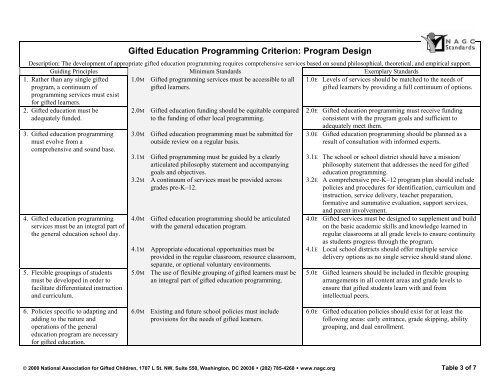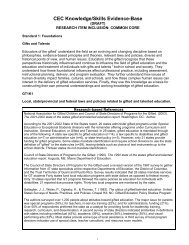Pre-K–Grade 12 Gifted Program Standards - NAGC
Pre-K–Grade 12 Gifted Program Standards - NAGC
Pre-K–Grade 12 Gifted Program Standards - NAGC
Create successful ePaper yourself
Turn your PDF publications into a flip-book with our unique Google optimized e-Paper software.
<strong>Gifted</strong> Education <strong>Program</strong>ming Criterion: <strong>Program</strong> Design<br />
Description: The development of appropriate gifted education programming requires comprehensive services based on sound philosophical, theoretical, and empirical support.<br />
Guiding Principles Minimum <strong>Standards</strong> Exemplary <strong>Standards</strong><br />
1. Rather than any single gifted 1.0M <strong>Gifted</strong> programming services must be accessible to all 1.0E Levels of services should be matched to the needs of<br />
program, a continuum of<br />
programming services must exist<br />
for gifted learners.<br />
gifted learners.<br />
gifted learners by providing a full continuum of options.<br />
2. <strong>Gifted</strong> education must be 2.0M <strong>Gifted</strong> education funding should be equitable compared 2.0E <strong>Gifted</strong> education programming must receive funding<br />
adequately funded.<br />
to the funding of other local programming.<br />
consistent with the program goals and sufficient to<br />
adequately meet them.<br />
3. <strong>Gifted</strong> education programming 3.0M <strong>Gifted</strong> education programming must be submitted for 3.0E <strong>Gifted</strong> education programming should be planned as a<br />
must evolve from a<br />
comprehensive and sound base.<br />
outside review on a regular basis.<br />
result of consultation with informed experts.<br />
3.1M <strong>Gifted</strong> programming must be guided by a clearly 3.1E The school or school district should have a mission/<br />
articulated philosophy statement and accompanying<br />
philosophy statement that addresses the need for gifted<br />
goals and objectives.<br />
education programming.<br />
3.2M A continuum of services must be provided across 3.2E A comprehensive pre-K–<strong>12</strong> program plan should include<br />
grades pre-K–<strong>12</strong>.<br />
policies and procedures for identification, curriculum and<br />
instruction, service delivery, teacher preparation,<br />
formative and summative evaluation, support services,<br />
and parent involvement.<br />
4. <strong>Gifted</strong> education programming 4.0M <strong>Gifted</strong> education programming should be articulated 4.0E <strong>Gifted</strong> services must be designed to supplement and build<br />
services must be an integral part of with the general education program.<br />
on the basic academic skills and knowledge learned in<br />
the general education school day.<br />
regular classrooms at all grade levels to ensure continuity<br />
as students progress through the program.<br />
4.1M Appropriate educational opportunities must be 4.1E Local school districts should offer multiple service<br />
provided in the regular classroom, resource classroom, delivery options as no single service should stand alone.<br />
5. Flexible groupings of students<br />
must be developed in order to<br />
facilitate differentiated instruction<br />
and curriculum.<br />
6. Policies specific to adapting and<br />
adding to the nature and<br />
operations of the general<br />
education program are necessary<br />
for gifted education.<br />
separate, or optional voluntary environments.<br />
5.0M The use of flexible grouping of gifted learners must be<br />
an integral part of gifted education programming.<br />
6.0M Existing and future school policies must include<br />
provisions for the needs of gifted learners.<br />
5.0E <strong>Gifted</strong> learners should be included in flexible grouping<br />
arrangements in all content areas and grade levels to<br />
ensure that gifted students learn with and from<br />
intellectual peers.<br />
6.0E <strong>Gifted</strong> education policies should exist for at least the<br />
following areas: early entrance, grade skipping, ability<br />
grouping, and dual enrollment.<br />
© 2000 National Association for <strong>Gifted</strong> Children, 1707 L St. NW, Suite 550, Washington, DC 20036 (202) 785-4268 www.nagc.org Table 3 of 7

















